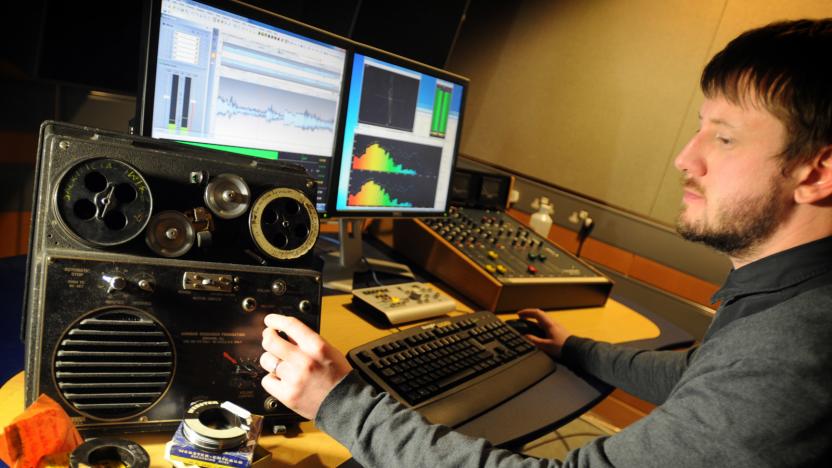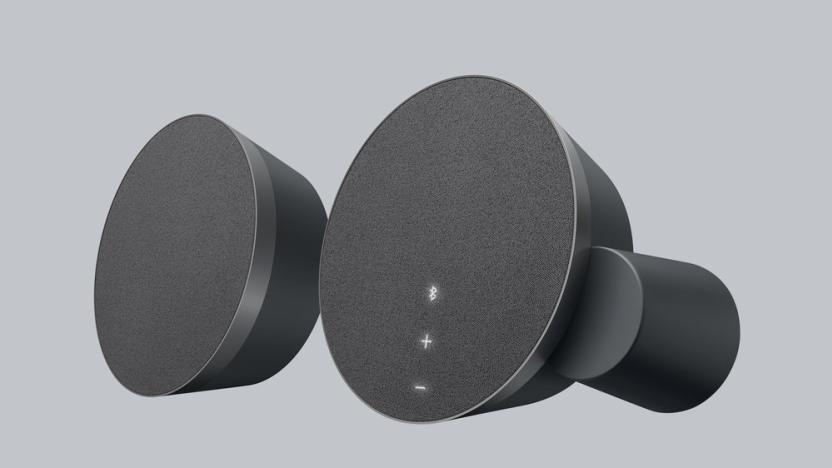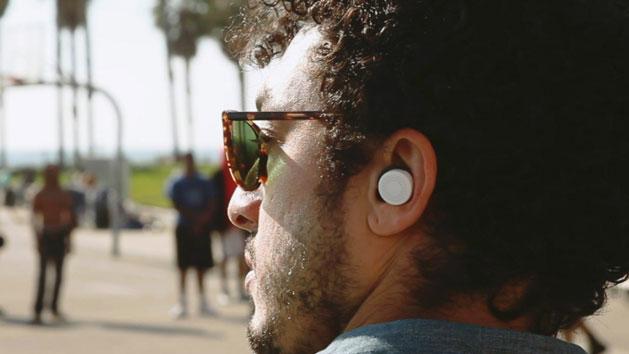sound
Latest

IKEA and Sonos are collaborating on a new range of products
Whether it's turning the heating on via a smartphone app or charging said smartphone by simply flinging it onto a table, home automation has a lot of appeal -- it's convenient, fun to play with and makes it a lot easier to be lazy. The main barriers to take-up, however, have been price and accessibility. Gear can be expensive and sometimes complicated. But furniture retailer IKEA -- arguably the antithesis of cost and complexity -- has slowly been bringing home automation to the masses with its Home Smart range, and is now turning its attention to sound products, in collaboration with Sonos.

British Library exhibit to highlight the sounds it’s fighting to save
Last year, the British Library began the "Save our Sounds" project, with the aim of accelerating the digitisation of millions upon millions of lost audio recordings held in its vast archive. The collection includes many rare and previously unreleased recordings of everything from speeches and music to wildlife, street sounds and pirate radio broadcasts. In some respects, it's a race against the clock. Time is taking its toll on ancient formats like the wax cylinder, for example, and the equipment needed to play some formats is extremely hard to come by. There's much to be done, but next month the British Library is celebrating achievements thus far with a free exhibition that "will explore how sound has shaped and influenced our lives since the phonograph was invented in 1877."

Logitech’s MX speakers have motion-activated controls
Among Logitech's suite of releases this week comes MX Sound, billed as 'the first premium Bluetooth speaker for your desk'. An elegant design and quality audio output make them a nice addition to your workspace, but it's the features within that actually make them a really useful addition. Alongside the ol' 35mm jack, you can pair up to two devices via Bluetooth and seamlessly switch between them. Simply pause music on one device and hit play on the other for instant playback -- no fiddling around with settings. You won't forfeit sound from your PC either, so you can play audio through a Bluetooth-connected device without missing alerts and chimes from your desktop.

ICYMI: Hyper directional sound guides runners
Today on In Case You Missed It: Malaysian sportswear company Ash Be Nimble has expanded their product line to include the Handbag Dyetonator, a fob-style accessory that will expel ink and smoke onto anyone who walks (or runs, or scoots) away with your bag. The Dyetonator attaches to a purse similar to a keychain and can be deployed via SMS message (so hopefully your phone wasn't in that bag...) to mark a thief for easy identification. It also contains a GPS tracker, should the culprit succeed in getting away with your pocketbook. It's still in early testing phases, and certainly isn't foolproof, but the idea of a dye pack exploding on a thief is a satisfying thought, so hopefully this will eventually make it to market.

Samsung is helping Sennheiser bring 3D audio to Android
When Sennheiser unveiled the first earbuds to use its Ambeo 3D audio technology, it limited them to iOS users. Are they ever going to come to Android? Yes, apparently -- with some help. Sennheiser has revealed that it's partnering with Samsung to bring Smart Surround's binaural, recording-based sound to Android devices. The company's Andreas Sennheiser says the collaboration is necessary for "credibility." South Korea is "one of the most technology-savvy countries," he says, and makes an ideal testing ground for new hardware. We'd add that Samsung is also the dominant Android phone maker, so any support from its side virtually guarantees a solid foothold in the market.

Even over-ear headphones tailor sound to your hearing
The personalized audio of MeQ's Even earbuds is sweet, but there's an obvious catch involved: you have to be a fan of in-ears to use them. What if you prefer the feel of headphone cups? Don't worry, you're set. MeQ is launching the Even H1, a set of wired over-ears that bring that same customized sound to a potentially more comfortable (not to mention more stylish) form. As before, the centerpiece is EarPrint tech that guides you through tailoring the output. You theoretically get music that accommodates your specific ear shapes, hearing loss and other factors that affect the listening experience.

Vine's soundboard lets you add audio memes to your loops
Vine is a six-second comedy echo chamber. As soon as someone creates a meme-worthy joke, the punch line phrase, sound effect or editing technique spreads like wildfire. Usually it's mere imitation, but sometimes Viners will remix the snippet into new, equally creative loops. To support this trend, Vine has added a "soundboard" feature that makes it easy for iOS users to import popular and recognizable clips. "LeBron James," "why you always lyin" and "freshavocado" -- to add these and others, just hit the soundwave icon after recording a new video. You'll then have access to the new library, which the company says will be updated over time.

The 'Inside' soundtrack was created with a human skull
Inside, the mysterious puzzle platformer by Playdead, continues the dark and isolating tone of its predecessor, Limbo. Much of the game's atmosphere can be attributed to the soundtrack, which offers a beautiful, yet haunting frame for the narrative. To nail this sombre mood, composer and sound designer Martin Stig Andersen turned to the human body. He found an old skull (yes, a real skull) and played the game's score through it, like an old school filter. The results were "quite bad," but Anderson persisted -- with a little post-processing, the final tracks were born.

Audiophiles in Japan are installing their own electricity poles
Audiophiles are known for doing some pretty extreme things in their quest for 'purer' sound, such as buying headphones that cost as much as a good car or getting ridiculously overdone cables with little to no practical benefit. However, the Wall Street Journal notes that some Japanese listeners are taking things one step further. When Takeo Morita worried that "tainted" power would affect the quality of his tunes, he installed a roughly $10,000 utility pole with his own transformer to get more electricity straight from the grid. And he's not alone -- there's a whole magazine dedicated just to selling audio-related power equipment, including poles.

Ultrasound can levitate large objects
Scientists have long dreamed of using acoustic levitation to float objects, but there has been one big catch: you couldn't lift an object larger than the wavelength without being picky about what you're lifting. However, it might not be a problem going forward. Researchers in Brazil and the UK have successfully levitated a polystyrene ball 3.6 times larger than the ultrasonic waves holding it up. The trick was to create a standing wave in the gap between the transducers and the object, instead of the usual pressure node between the transducer and a reflector. You can change the angle and number of transducers without messing with the effect, and it finally creates both horizontal and vertical lift -- you don't need physical support to prevent the object from drifting sideways.

Machines can generate sound effects that fool humans
Can machines come up with plausible sounds effects for video? Recently, MIT's artificial intelligence (CSAIL) lab created a sort of Turing test that fooled folks into thinking that machine-created letters were written by humans. Using the same principal, the researchers created algorithms that act just like Hollywood "Foley artists," adding sound to silent video. In a psychological test, it fooled subjects into believing that the computer-generated banging, scratching and rustling was recorded live.

US Army's smart earplugs spare soldiers from loud noises
As you might imagine, soldiers can't just use garden variety earplugs to protect their ears. It might tone down the sounds of explosions and gunshots, but it'll also prevent them from hearing a crucial command or an enemy on the other side of a doorway. It's less of an issue for the US Army these days, though. The military branch has been gradually rolling out a smart earplug, TCAPS (Tactical Communication and Protective System), that adapts to the audio realities of war. The smartphone-linked device softens louder noises, but amplifies quieter ones; if your squad leader needs to issue a command, you'll hear it over the din of battle.

NEC can verify your identity using sound-capturing earbuds
Sure, you could use your fingerprint to unlock your phone, but NEC developed a way to verify your identity with your ears. The corporation announced technology this week that used the way in which sound resonates in the ear canal to identify a person. Ear shape is also unique to each of us, so NEC created a way for microphone-equipped earbuds to measure the acoustics after sending out a sound. What's more, the company says the technology works with 99 percent accuracy and only takes about a second to take its measurements.

Mitsubishi uses sound and WiFi to locate you indoors
There have been many attempts at locating you indoors when GPS fails, but they usually come with catches. WiFi alone isn't very accurate, for example, while a ton of beacons isn't always practical. Mitsubishi may have a good answer to those problems, however: using two techniques at once. It just developed an approach that determines your location based on the time it takes for sound to reach positioning-capable WiFi access points. It's accurate to within 3.3 feet, and it works with as few as three hotspots -- which, of course, can get you online at the same time as they get you from A to B.

Watch the rock band Deerhoof experiment with sound at CERN
You knew that CERN was big on experimentation when it built the Large Hadron Collider, but it just took that curiosity in a strange, fascinating new direction. ATLAS physicist James Beacham has kicked off Ex/Noise/CERN, an initiative that has musicians experiment with sound at CERN in tribute to the institute's physics breakthroughs. The first band in the mix is the out-there indie group Deerhoof, and the results are about as odd as you'd expect -- the rockers' fuzz and bass sounds very, very different in an LHC magnet test facility versus a stage. Most of what they play in the clip below wouldn't be considered melodic, to put it mildly, but that's part of the point. This is the sort of listening that usually involves a dark room, some big headphones and an open mind. Here's hoping that the series carries on for a long while, and pushes more than a few creative boundaries. [Image credit: Marine Bass/CERN]

Scientists control a worm's brain cells using sound waves
Forget using clunky headsets and implants to control brain cells... one day, you might only need to use sound waves and some chemicals. Salk Institute scientists have found a way to control the brain cells of a tiny nematode worm through ultrasound. All they need to do to trigger activity is add a membrane ion channel to a neuron cell and blast it with ultrasonic waves -- in this experiment, the researchers changed the worm's direction through sound bursts. The approach is not only relatively unintrusive, but can reach deep into the body. You could trigger neural activity without ever hooking up an electrode, even for much larger animals.

The new Formula E cars sound like upset cats
The second season of Formula E kicks off in October, and there's one key difference for the championship's sophomore year: custom batteries and motors. The teams are now able to experiment with the car's powertrain, which includes the e-motor, inverter, gearbox and cooling system. That means the cars will perform differently on the track, adding a little extra strategy and excitement to the proceedings. What we didn't expect, however, is the sound of the cars to change -- watch the video below for a glimpse at how they'll be screeching off the starting grid. Is it me, or do they all sound like confused felines?

These smart earbuds are volume knobs for the real world
Your choices for filtering the sounds around you are typically quite limited: you either have to drown it out (such as through earplugs or headphones) or let all the annoyances in. Doppler Labs might soon have a way to be more selective, though. Its crowdfunded Here Active Listening earbuds are meant solely to control what you hear in the real world. You not only decide how much gets through, but how it gets through. There's an equalizer if you want to tweak certain sound frequencies (toning down the bass at a badly-mixed concert, for example), and there are preset filters designed to tune out common noises or add effects. Want to silence the background hum of your office without completely shutting out your coworkers? You probably can.

The British Library is fighting to save endangered sounds
For most of us, thinking about museums and archives will conjure up images of physical relics; faded books, paintings and trinkets discovered beneath the soil. But now, the British Library is fighting to preserve something more elusive: sound. With £9.5 million in fresh Lottery funding, it hopes to digitise and release 500,000 rare and at-risk recordings over the next five years. The challenge is that some audio snippets are currently held on old formats, such as wax cylinders and magnetic tape. They're slowly decaying to a point of irreparability, and the equipment required to play them is becoming harder to source. The British Library estimates that 1 million UK sound collections could be lost in the next 15 years, so in January it started a "Save our Sounds" campaign to preserve them.

Ultra HD Blu-ray is bringing high-res movies home soon
After Blu-ray and HD DVD ushered in the age of HD and 1080p movies for the masses, discs were beaten to 4K by streaming services like Netflix, YouTube and Amazon. While the internet is still doing most of the heavy lifting for 4K, the Ultra HD Blu-ray specification is finally complete which means we should see movies and players arriving later this year. Besides being compatible with the 10,000~ Blu-ray discs already out, Ultra HD Blu-ray players will be ready for high-res 3,840 x 2,160 video, "next generation object-based sound formats" (think DTS: X and Dolby Atmos), more colors, high dynamic range (HDR) and even high frame rate video. That's a lot of buzzwords to say movies will have the capability to look and sound better at your home than they ever have before. The BDA also made vague reference to a "digital bridge" setup for extending your movie purchased on a disc to other devices like phones and tablets, but didn't say exactly how that will work, or if it's going to be any better than Ultraviolet.







